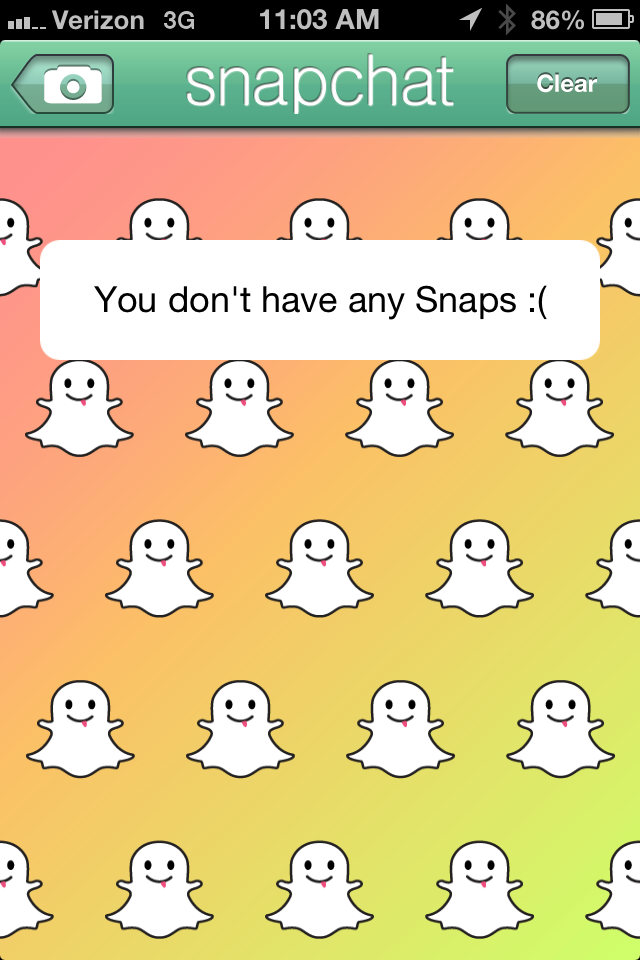Disposable social media–it’s “all the rage” (as my wife likes to say) among teens these days. Media outlets are claiming teens are turning to tools like Snapchat and Poke to share lewd messages–“sexting”, apparently, is running rampant across our world.
But, beyond the buzzwords, what is disposable social media all about? And why is it suddently so popular?
I decided to ask friend and fellow digital marketer, Greg Swan, a few questions about it since he has shown an interest and “passion” for disposable social media lately.

You’ve said before that you prefer “disposable social media” like Poke and Snapchat to more “traditional social media” like Twitter and Facebook. Why?
Disposable social media is a term I’ve started using to categorize online and social content that will not last forever. Unlike things cached by Google or our tweets stored in the Library of Congress, there is a new breed of social networking tools that purposefully don’t let its users archive or retrieve content once it has been viewed. As someone who spends their days concerned about online reputation management for my clients (and myself), this is quite refreshing.
Although there are those people who share too much and/or inappropriate content on social media, for the most part we humans are comfortable translating our censorship and self-aggrandizing skills from the real world to our social channels. Our profile pictures and cover images reflect our ideal state.
Our shared photos are perfectly cropped and filtered. Our bios are concise yet witty. Part of the appeal of an online persona is the ability to shape what we share with others — and what we don’t. We all now Stepford Wives. With the exception of the odd political post, a quick audit of my social channels show my friends, fans and followers are all in love with their jobs, significant others and perfect kids.
Everyone is traveling to exotic locations and/or eating the most wonderful-looking food. They are all master photographers and chefs, super parents and community organization leaders. Oh, and everyone is SO FUNNY. I mean, just really funny. And thanks to tools like Timehop, these beautiful, clever, exotic status updates, photos, checkins and shares can be relieved easy and often.
Disposable media is low-risk. It won’t last forever – on purpose!
I’ve sent people content through Facebook Poke I would never share on Facebook, Twitter and certainly not LinkedIn. Uncombed hair and unshaven face pictures. Food that didn’t look appetizing that I was eating anyway. Video of my kids not wearing pants at 2 p.m. screaming at me. You know – the life stuff you wouldn’t share on social media but that you might share with a friend (if it was lightweight enough and you knew it couldn’t be saved). I also use it for comedic terrorism, of which I cannot ever have my fill when it comes to my circle of friends.
Snapchat and Poke claim media (photos, videos) shared on their platforms are disposable. That is, they are deleted within 3-10 seconds after the user opens it. But, many media outlets have recently outlined hacks to get to that “disposable” media after its deleted. Do you see this as an obstacle for these tools and users? Or, are these media claims completely overblown? Do users even care, given the relative complexity of the hacks?
We humans have short memories. Only recently has it been physically possible to store every photo, save every email and review every text message every sent. Printed photos would fade and notes passed in sixth grade science class weren’t meant to archived for the duration of one’s life (and beyond!). We have quickly become accustomed to having access to everything we do online and on our phones – forever. These new apps are challenging data permanency. Will there be hacks and work-arounds? Yes, until those are closed (then there will be new hacks and work-arounds, etc. etc.).
Snapchat vs. Poke what do you think will win out over time? Why?
I don’t really care who has the legacy, because we’ll just move to that. Supposedly Facebook offered to buy Snapchat, was rebuffed and built Poke in 12 days. Twelve days! The social web starts and ends with Facebook, and they have an automatic market. But the diaspora of youth to non-Facebook destinations shouldn’t surprise anyone familiar with AOL, Friendster and (old) Myspace.
Facebook’s Poke was briefly #1 on the App Store’s list, but has fallen back signficantly since Dec. Does Poke have a future as a Snapchat rival?
Again, I’m not really focused on the apps themselves but more at how they add value to help solve a problem while influencing our behavior at interacting with one another.
Recently it seems like tools like Snapchat have been a trend with younger people (teens, especially)–do you see the coveted 25-44 demographic adopting these tools in the months/years ahead? Why or why not?
Teenagers like these apps for sexting. They do. But why? Because it’s disposable media. That’s the value proposition; not the chance to flash someone their private parts. If older generations find value in sending short bursts of content (text, photo, video), they will. And if they don’t, it didn’t offer enough value to attract users.
You’ve mentioned the term “success theater” before in our conversations–what do you mean by that? And how has that shaped how we participate in social media to date?
Everyone should this this NYT piece (http://bits.blogs.nytimes.com/2012/12/28/digital-diary-facebook-poke-and-the-tedium-of-success-theater/). Just as offline reputation matters in the meat-space (aka real world), one’s personal online reputation management can increasingly make or break the chance to land a job, keep a client, join a club or find a date. People spend hours crafting the perfect online profile and obsess Google results for their name. And that’s great. I counsel clients to do exactly this exercise, and we help them craft proactive reputation programs to influence what the public discovers and learn about key brands and individuals.
But the tedium of success theater, or strategically-constructed-online-reputation, can grow weary. I think especially for people in the PR industry, this is true. We are meticulous about photos we’ve been tagged in, search-optimize our profiles and more or less neuter our truest personality in social due to the long-term effects of data permanency. For example, if I have a bad experience at a big box store, with my cable provider or at a restaurant, I’m absolutely not going to bitch about it online. But I might share a Poke or Snapchat to a small group of friends…. if I knew it would never come back. I might also share a photo of myself not looking well-groomed or with dirty dishes in the sink in the background – and not think twice about it.
Is there opportunity for brands with disposable social media? What kinds of brands?
Perhaps, but to be honest the examples I’ve seen so far aren’t compelling, and my fear is that brands will have awkward requirements and/or ruin the trend. I guess that puts the pressure on us to come up with the genius idea, Arik.
Should marketers and PR folks have disposable media on their radar at this point or is it just way too early?
Marketers should absolutely be thinking about the human behavior of wanting to share content that will not live forever and be thinking about how that impacts their brands or clients. I recommend downloading every app and checking out every mobile experience you hear about. Then test it long enough to know how it works, and determine if it adds value to you or your client. If it does, move forward. If it doesn’t wait for the next thing. And keep in mind, there’s always a next thing.
 Greg Swan is the vice president of digital strategy at Weber Shandwick (Minneapolis office). He was one of the Minneapolis/St. Paul Business Journal’s 40 Under 40 in 2011 and also blogs at Perfect Porridge.
Greg Swan is the vice president of digital strategy at Weber Shandwick (Minneapolis office). He was one of the Minneapolis/St. Paul Business Journal’s 40 Under 40 in 2011 and also blogs at Perfect Porridge.

0 Comments